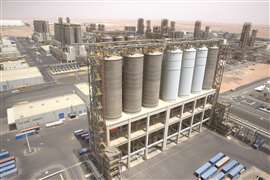Flurry of LNG projects
21 October 2024
Global demand estimated to rise by more than 50% by 2040
While U.S. liquefied natural gas project approvals may be on “pause”, a global flurry of activity underscores LNG’s staying power.
Global demand for LNG is estimated to rise by more than 50% by 2040, as industrial coal-to-gas switching gathers pace in China, South Asian and South-east Asian countries, according to Shell, which has stated it believes LNG will play a critical role in the energy transition, replacing coal in heavy industry.
Shell recently signed an agreement to invest in the Abu Dhabi National Oil Company’s (ADNOC) Ruwais LNG project in Abu Dhabi through a 10% participating interest.
 Saudi Aramco and the ADNOC are investing in U.S. lNG projects, including ones like the Rio Grande LNG project, signaling their confidence in long-term gas demand and ambitions to become global gas players. (Image: Bechtel)
Saudi Aramco and the ADNOC are investing in U.S. lNG projects, including ones like the Rio Grande LNG project, signaling their confidence in long-term gas demand and ambitions to become global gas players. (Image: Bechtel)
“In line with our strategy to create more value with less emissions, we are investing in additional LNG capacity and further growing our world-leading LNG portfolio, with energy-efficient and carbon-competitive projects,” said Shell’s Chief Executive Officer Wael Sawan.
The Ruwais LNG project will consist of two 4.8 million metric tonnes per annum (mmtpa) LNG liquefaction trains with a total capacity of 9.6 mmtpa. Shell, through its subsidiary Shell International Trading Middle East Limited FZE, has also signed an agreement to offtake 1 mmtpa of LNG produced by the project. The Ruwais LNG facility is set to have an electric-powered liquefaction system and will utilize access to a renewable power supply. This design supports lower operational emissions compared to traditional gas-powered LNG facilities.
ADNOC will hold a majority 60% share in the project and serve as the lead developer and operator of the facility, while Shell, BP, Mitsui and TotalEnergies will each hold 10%.
LNG deliveries are expected to start in 2028.
Advantages to LNG
According to data and analytics company Wood Mackenzie, the involvement of the companies in Ruwais LNG is not surprising, as the project is appealing on multiple levels:
Geographic location: Gives the project access to Asian and European markets.
Relatively low emissions: The project will be fully electric and powered by nuclear and solar energy sources. This will reduce the project’s emissions, making exports into markets with stringent emission regulations more appealing and will help align with the IOCs’ strategies for reducing emissions.
Reduced development risk: Ruwais LNG benefits from being post-FID, however, there could be delays in sanctioning other pre-FID projects. This suits the partners with ambitious LNG portfolio growth objectives by the end of this decade.
Supply outside the US and Qatar: The majority of new large-scale global supply is from the US and Qatar. Ruwais offers an alternative source of supply.
The involvement of each partner can be considered within their wider LNG corporate strategies, according to Wood Mackenzie.
For TotalEnergies, “the project will allow integration and optimization with its upstream assets in the UAE. This integration is a key theme across TotalEnergies’ LNG strategy and one it has used to grow its equity LNG globally. Ruwais LNG will also provide some ailment to the loss of volumes from Arctic LNG-2 and potential loss from Yamal LNG if sanctions against Russia increase,” the company wrote in a recent report.
Similar to TotalEnergies, this will allow BP (who hold a 10% interest in ADNOC Onshore) to integrate with its UAE upstream business.
“Interestingly, this is BP’s first entry into an equity LNG position since its 2020 policy to reduce its oil and gas production by 2030 by 40% (compared to 2019 numbers). Instead, growth has largely been driven through new third-party offtake. That said, it revised its reduction target to 25% in 2023 suggesting it would be going longer on oil & gas, a remark further supported by this pivot back to equity LNG,” according to Wood Mackenzie.
Following on from its acquisition of Pavilion’s LNG assets, this deal is another step for Shell towards its aim to grow its LNG business by 20 to 30% by 2030, compared to 2022. With this, Shell maintains its position as the number one IOC in LNG.
“Shell has also been vocal on the need for LNG in the energy transition – lower emission projects such as Ruwais LNG will be vital for LNG to prosper in a low-carbon world,” Wood Mackenzie wrote.
 General view of the Borouge petrochemical facility at ADNOC’s Ruwais Industrial Complex in Ruwais, United Arab Emirates. Shell and other major companies recently invested in an LNG project at the site, underscoring the companies’ commitment to LNG. (Image: Reuters)
General view of the Borouge petrochemical facility at ADNOC’s Ruwais Industrial Complex in Ruwais, United Arab Emirates. Shell and other major companies recently invested in an LNG project at the site, underscoring the companies’ commitment to LNG. (Image: Reuters)
Mitsui & Co has expanded its LNG business globally. The lower emission intensity of the project is one of the key drivers for Mitsui, according to Wood Mackenzie. Additionally, Ruwais could replace volumes that have been delayed and may not reach the market from Arctic LNG 2 and Mozambique LNG.
Long-term play
According the Arab Gulf States Institute in Washington (AGSIW), an independent, nonprofit institution dedicated to highlighting the importance of the relationship between the United States and the Gulf region, investing in LNG projects is a key strategy for several companies.
Saudi Aramco and the ADNOC are investing in U.S. lNG projects, signaling their confidence in long-term gas demand and ambitions to become global gas players, according the AGSIW.
In June, Saudi Aramco announced two U.S. LNG deals. It signed a 20-year nonbinding offtake deal with NextDecade for 1.2 million tons per year (mt/y), to be supplied by proposed Train 4 at Rio Grande LNG. And on June 26, Saudi Aramco signed a heads of agreement with Sempra for a 20-year sales and purchase agreement for 5 mt/y from the proposed Phase 2 expansion of Port Arthur LNG. Saudi Aramco could also acquire up to a 25% equity stake in Port Arthur Phase 2. The first phase of Port Arthur LNG, now under construction, includes two trains with capacity of 13.5 mt/y, and Phase 2 could double this amount with another two trains. Saudi Aramco billed the nonbinding deal as “a major step in Aramco’s strategy to become a leading global LNG player.”
On May 20, ADNOC announced an 11.7% equity investment in Phase 1 (Trains 1 to 3) of Rio Grande LNG, a NextDecade-operated project in Texas with planned capacity of 17.6 mt/y. ADNOC acquired its stake through the existing equity holding of Global Infrastructure Partners, and the company could take an equity stake in proposed Trains 4 and 5 at Rio Grande LNG, subject to a final investment decision for the project expansion. ADNOC also announced a preliminary 20-year offtake agreement for 1.9 mt/y from proposed Train 4 at Rio Grande LNG. The partners called the deal “ADNOC’s first strategic investment in the US.”
“These deals reinforce the commercial appeal of U.S. LNG and suggest that Gulf national oil companies represent a new pool of capital for global gas investment,” the AGSIW wrote in a recent report. “It is notable that some of their first forays into international LNG have occurred in the United States, especially in a period of shakier policy support in Washington for LNG exports. The deals suggest that Washington’s relations with Riyadh and Abu Dhabi are improving.”
I
STAY CONNECTED



Receive the information you need when you need it through our world-leading magazines, newsletters and daily briefings.
CONNECT WITH THE TEAM






